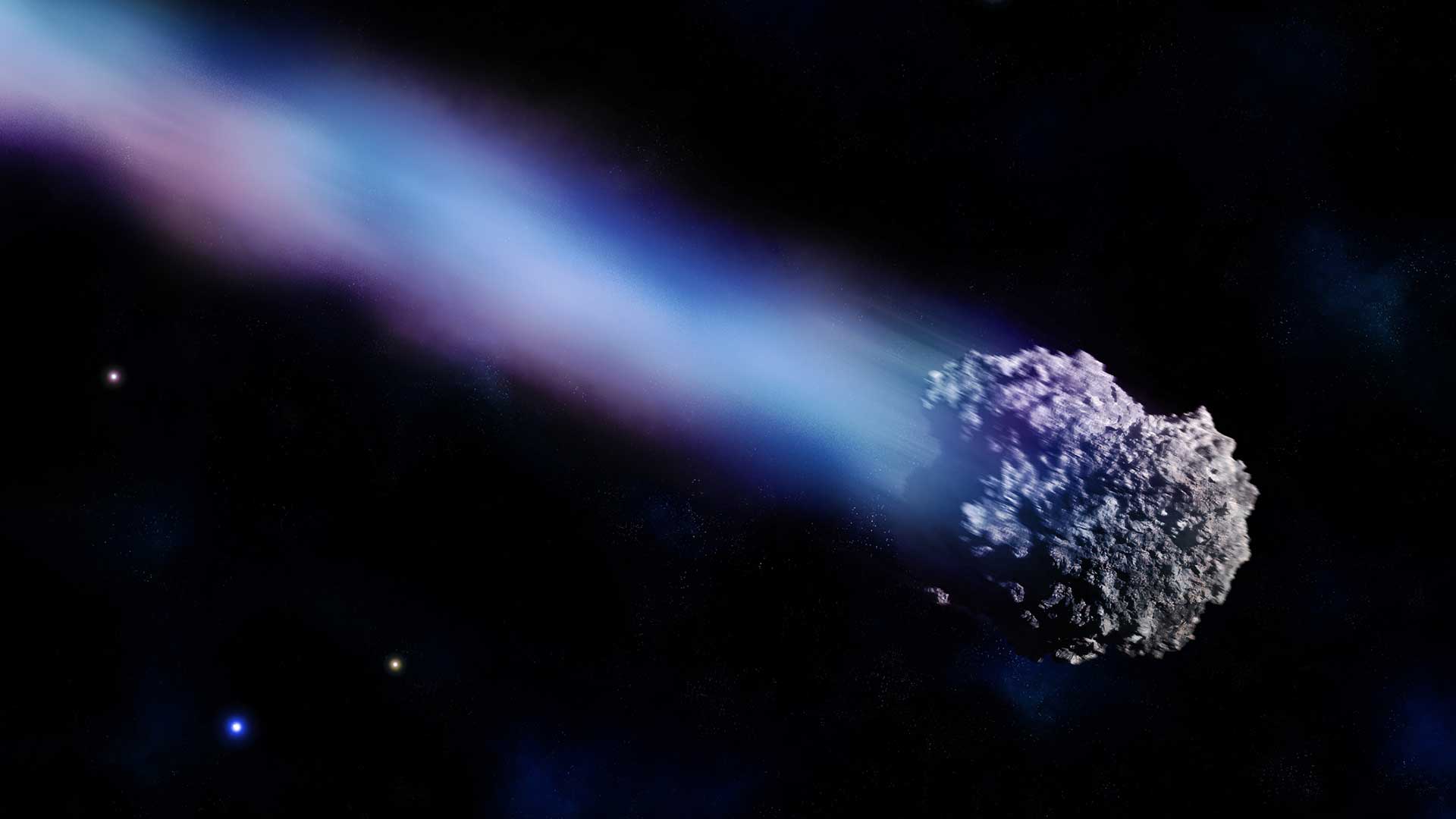Recently discovered Comet Pan-STARRS could be visible in April's night sky (maybe)

A big question for skywatchers during the upcoming weeks is what will become of a recently-discovered comet heading toward a late April rendezvous with the sun. The new visitor has apparently made its way into the inner solar system from the Oort cloud.
The Oort cloud is an immense, thick-walled spherical cloud, hypothesized to be the primary source for countless billions of comets. It is believed that the outermost limits of this comet cloud may reach out into space for some 15 trillion miles.
The new object is comet Pan-STARRS, known officially as C/2021 O3 (Pan-STARRS), which was discovered on July 26, 2021 by astronomers using the Panoramic Survey Telescope And Rapid Response System, or 'Pan-STARRS' telescope, a 70.9-inch (1.8 meters) Ritchey-Chretien reflector stationed at Haleakala, Hawaii.
Related: Amazing photos of Comet Leonard in the night sky
If you take a photograph of comets and planets, let us know! You can send images and comments in to spacephotos@space.com.
If you're looking for binoculars or a telescope to see comet Pan-STARRS or other objects in the night sky, check out our guides for the best binoculars and best telescopes. If you need photography equipment, our best cameras for astrophotography and best lenses for astrophotography guides can help you prepare for the next celestial sight.
When it was discovered last summer, Pan-STARRS was 402 million miles (648 million km) from the sun — out beyond the orbit of Jupiter — and 355 million miles from Earth. At that time, the comet was shining roughly 400,000 times dimmer than the faintest star visible to the eye.
But at its impending perihelion (closest point to the sun) on April 21, its solar distance will have shrunk to roughly 26.7 million miles (42.9 million km) away, placing it well inside the orbit of Mercury. Such an enormous change in the solar distance would typically cause a comet to increase its intrinsic luminosity by about 16 magnitudes, possibly making it visible to the unaided eye. Furthermore, PanSTARRS will make its closest pass to the Earth on May 8 at a distance of about 56 million miles (90 million km).
Breaking space news, the latest updates on rocket launches, skywatching events and more!
Out of sight
At this moment, thanks to the comet's close proximity to the sun it is unobservable. In fact, the last 'reliable' observation of it dates back to Feb. 1 by the Japanese observer, Ken-ichi Kadota. At that time, it was still very faint. It certainly would be helpful if we could monitor the comet's brightness over time to see how it is developing and whether or not it is brightening in accordance with predictions, but unfortunately, that's not possible in this particular case; we can only guess what is taking place regarding Pan-STARRS performance to date.
Evening appearance
After it sweeps around the sun and moves back out into space, Pan-STARRS will slowly move out of the bright solar glare and by the end of this month, into the early evening twilight sky.
By then it might be as bright as the sixth magnitude, suggesting that it 'may' be at least dimly visible to the naked eye in dark skies, though far better seen in binoculars or telescopes. We should note that magnitude is the degree of brightness of an object in the sky. The lower the figure of magnitude, the brighter the object. The brightest stars in the sky are zero or first magnitude. The faintest stars visible to the eye on dark, clear nights are sixth magnitude. First magnitude stars are 100 times brighter than those of the sixth magnitude).
Not easy to see

Sixth magnitude is the kind of brightness that would still make Pan-STARRS a decent comet from the viewpoint of an experienced amateur astronomer. But at this moment in time, it doesn't appear that this comet will evolve into the kind of spectacle that comet NEOWISE was in 2020 or comet Leonard last December in grabbing the public's attention. And because it will be rather low in the west-northwest sky it could very well be difficult for astronomy neophytes to pick up.
Perhaps your best chance of making a sighting will come on the evening of May 2, when you could use three conspicuous celestial objects to help 'point the way' to Pan-STARRS. Those three objects will be a crescent moon, the planet Mercury and the Pleiades star cluster.
Using binoculars, approximately 45 to 50 minutes after sunset, scan low above the west-northwest horizon. You should be able to easily see the slender sliver of the moon, just a little over two days past the new phase. Then, situated 4 degrees to the lower right of the moon, you'll see a bright 'star' shining with a yellow-orange glow. That will be the planet Mercury. And about 3 degrees to the lower right of Mercury, you should be able to find the tiny silver cloud of stars that comprise the Pleiades.
Now, using the distance between the Pleiades and the position of the moon as a sort of celestial yardstick, check out that part of the sky with binoculars a similar distance — about 6 degrees — to the Pleiades' upper right. If comet Pan-STARRS is living up to its modest expectations, you might see a circular, wispy patch of light with perhaps a short tail protruding almost straight up from the horizon.
It is high... it is far... it is gone!
In the nights that follow, the comet will track rapidly northward and get progressively higher in the northwest sky. Its projected path takes it through the constellations of Perseus (May 4 to 10), and Camelopardalis (May 11 to 28). On May 8, the same day that it will be closest to Earth, Pan-STARRS will become circumpolar for observers who live north of latitude 40-degrees; that is, it will remain above the horizon all night long, neither rising nor setting. Thereafter, it will be receding from both the sun and Earth, back into the far reaches of the solar system.
On May 27, it will pass closest to Polaris, the North Star (8.5 degrees) but by that time it will have faded considerably from what it was at the start of the month. Current estimates have it diminishing to seventh-magnitude by May 7, eighth-magnitude by May 13, ninth-magnitude by May 19 and 10-magnitude by May 27.
Predictably unpredictable

However, although the script has been written here detailing Pan-STARRS upcoming performance, be advised that comets are notoriously bad actors. Just to prove how capricious comets can be, both comet NEOWISE and comet Leonard were overachievers and became brighter than original predictions had suggested.
Neither of these comets were expected to provide much of a show, but at its brightest NEOWISE reminded many of a miniature version of comet Hale-Bopp, while Leonard exhibited several unexpected outbursts of activity that more than doubled its expected brightness while sporting numerous streamers, kinks and knots that changed the shape of its narrow bluish ion tail.
This having been said, comet Pan-STARRS could also unexpectedly brighten up and give us a real surprise. Still, few celestial events have greater false-alarm potential than these interplanetary vagabonds do.
Bad lineage
Unfortunately, the odds that Pan-STARRS could overperform are not very good. As was mentioned earlier, orbital calculations indicate that it is coming directly from the Oort cloud; thus, it is making its very first visit to the vicinity of the sun. From observations of other comets with a similar pedigree, we know that they tend to be poor performers.
Such 'new' comets traveling in parabolic orbits may be covered with volatile material such as frozen nitrogen, carbon monoxide and carbon dioxide. These ices vaporize far from the sun, giving a distant comet a short-lived surge in brightness that can raise unrealistic expectations. Probably the most noteworthy example of these comet-flops was the infamous Kohoutek in 1973.
Other Oort cloud comets that approached unusually close to the sun disintegrated before they swept completely around it. Comet ISON in 2013 did just that. Unfortunately, some astronomers feel that this will ultimately be Pan-STARRS fate as well. We'll just have to wait and see.
If it manages to survive, this will be its only visit to the sun. Pan-STARRS will then be flung on a path taking it completely out of the solar system never to return again.
If you snap a stunning photo of comets and planets, or any other skywatching sight, that you'd like to share with Space.com for a possible story or gallery, let us know! You can send images and comments in to spacephotos@space.com.
Joe Rao serves as an instructor and guest lecturer at New York's Hayden Planetarium. He writes about astronomy for Natural History magazine, the Farmers' Almanac and other publications. Follow us on Twitter @Spacedotcom and on Facebook.

Joe Rao is Space.com's skywatching columnist, as well as a veteran meteorologist and eclipse chaser who also serves as an instructor and guest lecturer at New York's Hayden Planetarium. He writes about astronomy for Natural History magazine, Sky & Telescope and other publications. Joe is an 8-time Emmy-nominated meteorologist who served the Putnam Valley region of New York for over 21 years. You can find him on Twitter and YouTube tracking lunar and solar eclipses, meteor showers and more. To find out Joe's latest project, visit him on Twitter.

